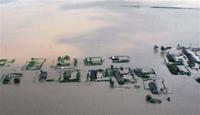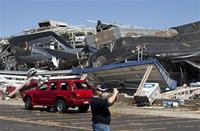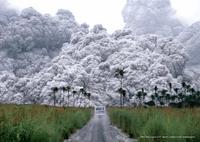-
Oh my, the trouble with evacuating lions, tigers, and bears

Rescuing and housing the many exotic animals at Minot, North Dakota’s Roosevelt Park Zoo from record floods presented zoo workers with a unique challenge; it was no small feat finding vehicles large enough for giraffes or getting dangerous animals like bears and wolves to cooperate; currently more than 100 animals are housed in an old furniture warehouse; makeshift pens hold deer, emu, warthogs, bobcats, monkeys and chickens, while workers struggle to keep the animals comfortable
-
-
Severe flooding in China destroys crops, food prices soar

China’s beleaguered farmers were dealt another blow as devastating floods inundated much of the country’s east, south, and southwest; the water has caused more than $5 billion in damage, displaced more than 1.6 million people, and killed at least 175 people; the floods have destroyed large portions of crops and will reduce vegetable yields by an estimated 20 percent in some areas; more than one million acres of crops have been destroyed across the country pushing grain and vegetable prices higher
-
-
Weather variations cost U.S. $485 billion a year

New research finds that routine weather events such as rain and cooler-than-average days can add up to an annual economic impact of as much as $485 billion in the United States; the study found that finance, manufacturing, agriculture, and every other sector of the economy is sensitive to changes in the weather, and that the impact of routine weather variations on the economy is as much as 3.4 percent of U.S. gross domestic product
-
-
SBA offers loans to nonprofits in Vermont
The Small Business Administration (SBA) just announced today that certain private non-profit organizations (PNPs) in Vermont could qualify for special low-interest federal disaster loans; the announcement comes following the presidential disaster declaration in counties severely affected by the devastating storms and flooding that occurred in late April and early May; SBA said that PNPs not providing critical services of a government nature in Addison, Chittenden, Essex, Franklin, Grand Isle, Lamoille, Orleans, and Washington counties are eligible for Physical and Economic Injury Disaster Loans
-
-
Artist fundraises to build prototype disaster relief shelter
An artist from Amherst, Virginia is currently fundraising to build a prototype temporary house that can be quickly and cheaply built for displaced families; with the help of www.Kickstarter.com, a New York based website that helps artists find funding, Craig Pleasants is trying to raise roughly $28,000 to fund his project; the shelter is shaped like an octagon to maximize space and is designed to withstand storms and wind
-
-
California county's federal assistance request rejected
On Tuesday, federal authorities denied Santa Cruz’s request for federal aid to assist with cleanup efforts from the storms that pelted the region in March; the heavy rain caused $17 million in damage from floods and mudslides across the county; FEMA said the storms that hit California “were not severe, continuous and were not beyond the combined capabilities of the state and affected local governments”
-
-
FEMA extends federal aid deadline for North Carolina

The Federal Emergency Management Agency (FEMA) has extended its deadline to register for federal disaster assistance for those in affected counties in North Carolina; at the request of North Carolina Emergency Management (NCEM), FEMA agreed to give residents an additional fifteen days to turn in their paperwork; the new deadline is Tuesday 5 July
-
-
Nebraska nuclear plant on flood alert
Levees in northern Missouri were failing late Saturday and Sunday as a result of massive release of water from upstream dams; farmland and houses in two Missouri counties — Holt and Atchison — were flooded and residents evacuated; two Nebraska nuclear power plant place on flood alerts
-
-
UN body approves measure advancing Iran's nuke program
The UN Economic and Social Commission for Asia and the Pacific (ESCAP), over a strenuous U.S. opposition, approved a measure committing the UN to supporting what the Iranians call a “disaster information management center”; the United States managed to defeat the Iranian proposal for the center several times in the past, but this time Iran, exploiting concerns about climate change, repackaged its proposal and tied it to a broader UN effort to help Asian countries prepare for climate change-induced natural disasters; the technologies with which the center will be provided — technologies which are otherwise unavailable to Iran because of the UN sanctions imposed on the country — will give Iran much-improved satellite-imagery and missile-control capabilities; these technologies will dramatically bolster Iran’s target selection, target-destruction, and bomb-damage-assessment capabilities; as is the case with any other new nuclear weapon state, Iran will initially have very few nuclear bombs in its arsenal; the technologies approved by ESCAP for delivery to Iran will allow the ayatollahs to make a much more efficient — and effective — use of their small arsenal — and make their threats to use this arsenal more credible
-
-
Mississippi River floods to cause large Gulf of Mexico dead zone
Hypoxia, which creates oceanic dead zones, is caused by excessive nutrient pollution, often from human activities such as agriculture, which results in too little oxygen to support most marine life in bottom and near-bottom water; scientists are predicting the dead zone area in the Gulf could measure between 8,500 and 9,421 square miles, or an area roughly the size of New Hampshire; the largest hypoxic zone measured to date occurred in 2002 and encompassed more than 8,400 square miles
-
-
Arizona wildfire now largest in state's history

The Wallow wildfire in Arizona has continued to burn out of control and is now the largest fire in Arizona’s history; on Tuesday firefighters in Arizona reported that they had 18 percent of the fire contained; so far the blaze has burned 479,407 acres in the White Mountains of eastern Arizona; officials have evacuated thousands of residents from mountain towns and are urging residents to stay clear as the smoke has created dangerous air conditions
-
-
Era of major volcanic eruptions nears

The recent volcanic eruptions in Iceland upset airline bosses and caused a lot of fuss, but they were trivial by comparison with what could happen next, according to Clive Oppenheimer’s new book; 10 percent of the world’s population and at least twelve major cities now located within range of a volcano, so a more accurate perspective is needed on what they can do, so that rational plans can be drawn up in preparation for future events
-
-
Montana floods cause $8.6 million in damage to infrastructure
Towns in Montana have been hit particularly hard by floods, causing an estimated $8.6 million in damage to public infrastructure; officials expect that figure to increase in the coming weeks as flooding will continue for some time
-
-
Firefighters struggling with Arizona's second largest wildfire in history

Firefighters in eastern Arizona are struggling to contain the second largest wildfire in the state’s history; as the blaze burns toward New Mexico, Arizona officials have been forced to evacuate mountain resort communities and close national forests and parks; the wildfire has been burning steadily since 29 May; the conflagration now covers more than 311,000 acres in the White Mountains of eastern Arizona, and is threatening to damage power lines carrying electricity to Tucson; the fire is growing at a rate of four to five miles a day and protracted drought and dry, high winds have hampered efforts to control the blaze
-
-
Torrential rains hit Haiti, killing 23
Haiti has never recovered from the massive earthquake that hit it more than two years ago; the country lacks basic infrastructure, and torrential rains turned streets into rivers and buried buildings under mountains of mud
-
More headlines
The long view
The Surprising Reasons Floods and Other Disasters Are Deadlier at Night
It’s not just that it’s dark and people are asleep. Urban sprawl, confirmation bias, and other factors can play a role.
Why Flash Flood Warnings Will Continue to Go Unheeded
Experts say local education and community support are key to conveying risk.
